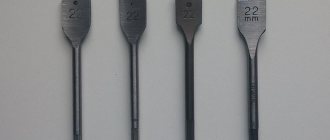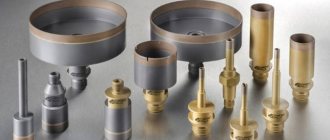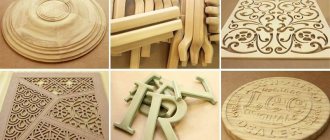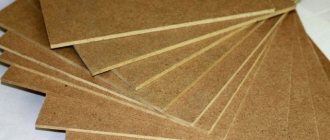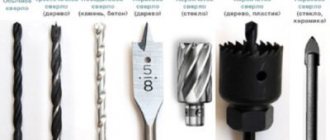A wood drill is a tool that is constantly in use at home. Each type has its own characteristics. The selection is made depending on the hardness of the material being processed and the parameters of the future hole. Attention is drawn to the absence of flaws that may be present in the drilling element. There should be no scratches, dents or nicks on the surface. The presence of such defects will affect the quality of the final work.
Areas of use and design features
The market for tools and accessories is full of a variety of wood drill bits to choose from. Woodworking tools are used in accordance with the specifications, design and type of work being performed. The functionality of one drill can be limited; under heavy loads it can break and damage the part. To eliminate curious cases, a wood drill is used in accordance with technical parameters.
A home craftsman must distinguish between varieties and types in order to perform the safest and highest quality work possible.
When purchasing, you should pay attention to the quality of the gimlet; the main structure and cutting part must be free of chips and cracks, well processed and evenly sharpened.
Based on the color scheme, it is possible to determine the treatment and purpose:
- A steel-colored product indicates a lack of processing.
- A yellow-bronze tint is obtained by metal during processing to relieve metal stress.
- The bright golden color indicates titanium nitride treatment, which is used for durability and reliability of the countersink.
- The strength of the tool is increased by superheated steam; the black color indicates this when purchasing.
An example of using a wood drill
It is necessary to pay attention to the size of the drill. A long wood drill is not always useful for the farm, since the longer the drill, the larger its diameter. Long gimlets are used for processing soft wood at medium tool speeds. The larger the size indicators, the lower the revolutions should be, because there is a possibility of the drill breaking off and damaging the workpiece.
It is necessary to correctly select the ratio of weight to the required hole. The greater the length and diameter of the wood drill, the lower the drill speed should be.
Compliance with this rule will help preserve the instrument for as long as possible. If a twist drill cannot produce the required hole size in wood, a ring type drill is used. The appearance of ring drills for wood resembles crowns and has a ring with jagged edges. The length of this type of product does not differ in special parameters, and the width of the outlet hole can be made up to 60 mm. The tool is also allowed to work with soft materials - plastic and plasterboard.
For other materials
Most of the above cutters are used to work with different materials. But provided that they are made of hard, durable cutting alloys such as HSS or have soldered cutting edges made of hard alloys with tungsten or vanadium carbide. Then they are processed:
- tree;
- Chipboard, laminated chipboard, fibreboard, MDF, OSB;
- plywood;
- drywall;
- solid insulation - polystyrene foam, fiberboard, etc.
A cutter made of weak metal can cope with wood, but on hard adhesive resins chipboard, laminated chipboard, fibreboard, MDF, OSB it will quickly wear off and become dull. The same applies to drywall - it is a soft material, but with high abrasive (erasing) properties.
For plastic
Plastic can be processed with a drill using any of the above cutters. However, plastics are different, including very fragile ones. Therefore, trial processing is required on an unnecessary piece of material. The cutter for such fragile plastics must be sharp. Processing is carried out at maximum drill speed (if there is a regulator), smoothly and without strong pressure.
For ceramics, tiles and aerated concrete
To process hard materials with a drill (ceramics, brick, concrete, tiles), cutters are used - crowns similar to those described above. The difference is that instead of teeth, these special cutters have carbide coating. This could be tungsten carbide, artificial diamond coating, or other alloys that do not wear off on hard materials.
Milling cutter - crown
The centering cone drill is also made of a soldered carbide cutter.
The main purpose of such equipment is to make holes in the walls for electrical sockets, switches, junction boxes, etc.
Selecting the required type of drills for a home workshop
The sets of tools for woodworking included in power tools are not very diverse. Therefore, for comfortable work, you select your own set of tools, depending on the type and material of the work. Wood drills are divided into types, depending on the type and hardness of the material. It is necessary to choose a high-quality wood drill; the main characteristics should differ in conditional parameters.
Spiral
The most common type are twist drills for wood.
Spiral
Different diameters from 3 to 50 mm allow you to perform a different range of work; the pointed end is necessary for balancing the electric drill. A cone-shaped shank is used in cases where it is necessary to adjust the drilling point. It is worth taking into account the hardness of the rocks and the diameter of the gimlet when making parts. For example, with a drill with a diameter of 12 mm, it is possible to drill soft material at a speed of about 2000 per minute, when with hard rocks the speed is halved. Using the woodworking kit in accordance with the technical regulations and for its intended purpose can extend the service life and maintain the sharpness of the cutting element.
Long drills
Drills of unique and different lengths are used in non-standard situations; it must be taken into account that the longer the length, the larger the diameter.
Long wood drill
The increased length can cause the tool to be heavy; a conventional electric drill is not able to rotate a heavy shaft. To drill lengths with a drill, a mixer is used - a stirrer operating at low speeds with low force.
Screw
A subcategory of spiral products are screw drills. The drilling process occurs by drilling against the growth of wood fibers. The screw drill also comes in different diameters, lengths and weights. For example, a wood drill with a diameter of 4 centimeters will have a length of 600 cm and a weight of just under 1.3 kilograms. A design feature is the presence of a threaded screw, which allows the removal of wood chips. The threaded tip is used for precise installation of the tool when working with materials.
Wood screw drill
It is important to understand that a smaller drill diameter cannot be associated with an increased length of the product. There are narrow and long versions of the tool on the market, but a reliable process cannot be achieved with them due to the fragility of the material and the wrong choice of power tool speed.
Feather
The most balanced in weight and design is the feather type. The accuracy and quality of processing will not have high parameters, so this version of the gimlet is not applicable for decorative work.
Feather
Work is carried out at increased speed due to the lightweight design and simple adjustment. The hole width range can vary from 10 to 60 mm, depending on the type of structure. The length of the treated surface can be adjusted with a special adapter - an extension, which allows you to increase the depth to 30 centimeters. The process must be carried out without stress on the tool, since the drill can break when heated, due to its fragile design.
Forstner drill
Blind holes for fastening hinges, handles and other accessories are made using a Forstner drill. The cutting edges are located on the side plane, making it possible to process holes with a flat bottom. The main difference of the kit is that it does not heat up during operation and is capable of performing precise work based on the correct direction of drilling. The dimensions and diameter of the holes depend on the choice of instrument; an analogue of this type of instrument is a ballerina.
Forstner drill
The ballerina allows you to adjust the diameter of the future hole in the tree, thanks to a special mechanism. Buying one universal tool when working with wood can replace a whole set, and is convenient for storage and transportation.
Ring
The annular type of drills allows you to make large-diameter holes, also called crowns. The appearance implies a ring with jagged edges along the entire edge. It is common to use sets in which there is a different choice of equipment according to diameter.
Wood drill bit
The guide bur is located in the center of the disk, then there is a mechanism for attaching removable tips. The universal set allows you to process thin-walled products and materials.
Countersink
Drilled holes for connecting elements, bolts or screws, often need to be masked. The countersink is used in conjunction with a depth limiter for proper processing of wood.
Countersink
A replaceable centering tip for wood with a diameter of 4 mm is fixed using a clamping mechanism with a screw.
Flexible
It should be noted right away that the drill material cannot be flexible and has not yet been developed. The name of a flexible tool for work is a mechanism inserted into a cartridge, a kind of extension.
Flexible wood drill bit in use
The use of an adapter allows you to transfer the torque of a drill or screwdriver to a drill located in a hard-to-reach place. Varieties of small length and diameter are used; the design will not withstand a massive woodworking tool.
Main types
The main parameter, depending on which wood drills are divided into different types, is the design of the working part. Based on this feature, wood drilling tools may fall into one of the following categories.
Feather
Drills of this type are used to make holes of medium diameter in wood - up to 25 mm. It is advisable to use such a tool in cases where the requirements for the accuracy of geometric parameters, as well as for the quality of the holes, are not too strict. Among the most significant advantages of pen drills, low cost and ease of maintenance should be noted.
Feather drills are considered the most affordable
Core drills
Core type tools are designed for drilling large diameter holes. In terms of their design, wood crowns resemble a metal glass with a shank, the working end of which has cutting teeth. When such a drill rotates, its cutting teeth, interacting with the workpiece, cut out a circle of the required diameter on its surface.
Set of wood crowns
Spiral
Spiral wood drills are also called screw drills. Their working part resembles a screw. They are used for drilling small diameter holes in wood. Due to the special design of screw-type drills, chips are effectively removed from the processing area when used. The twist drill also ensures high precision and extremely high quality machining.
Spiral wood drill with scoring
Forstner
These are tools that are used to create not through, but blind holes with a perfectly flat bottom in wood products. In addition, if you use such a wood drill with additional accessories, you can drill a square hole in a wooden product.
Many modifications of Forstner drills are produced.
Milling
With the help of such tools, it is possible not only to drill wood, but also to make grooves of various configurations in wood products. Drills of this type are most often used in cases where it is necessary to perform complex processing of wooden parts, and in order to drill a regular hole, a twist drill, a feather or a core tool is used.
Milling drills are designed for drilling a round hole and then boring it to the desired shape. Used when working with wood and thin metal
The shank of drills designed for woodworking is usually cylindrical, but manufacturers also produce them with shanks of other configurations. So, on the modern market you can buy drills for woodworking, the shanks of which can be:
- triangular, optimally suited for fixation in a three-jaw chuck (tools with a triangular shank are ideally transmitted torque, and even very significant loads are not able to turn it in the chuck);
- hexagonal (tools with such shanks can be installed in both a standard and a three-jaw chuck, but there is a very high risk of the drill turning when subjected to heavy loads);
- conical (tools with shanks of this type are used primarily to equip production equipment);
- tetrahedral (a rarely used form of shanks, which, however, ensures high stability of the tool against rotation in the chuck).
Advantages and disadvantages
Each cutting set is designed to perform specific jobs under different operating conditions of the equipment.
Before processing wood, it is important to evaluate the type of hole required and the material. Properly performed preparatory work and the use of tools allow you to obtain high-quality results and durable operation of the devices.
The functionality is described in the instructions or on the product packaging; if there is no information, you must contact a specialist for clarification on the technical data.
How to make it yourself
Milling cutters, despite their apparent simplicity, are a high-tech product. Special metals, alloys and technologies are used in their production. Therefore, it is extremely difficult to make a cutter with a complex profile yourself without special equipment.
However, there are exceptions. For some unique operations, you can make a primitive semblance of a drill cutter with your own hands. Example in the following video:
Today, craftsmen have access to a wide selection of milling equipment for drills. And this expands the capabilities of every master. It is enough to choose a suitable cutter and with the help of a conventional drill or screwdriver you can solve various problems in construction, repair, furniture and carpentry workshops.
Features of wood drilling work
There are a huge number of products offered on the market. The varieties do not stop at the list presented; for example, to obtain conical tenons, plug-type drills are used. Holes in wooden structures can be made with any available material, even a milling cutter or drill.
Drilling technology depends on the thickness and density of the material. Usually the work is carried out initially with a drill of a smaller diameter to prevent chipping on the back side of the product. The process is preferably carried out on both sides according to the prepared markings. When this opportunity is not provided, a wooden beam is placed at the point where the drill exits the workpiece. To obtain the necessary recesses, the marks necessary to visualize the process are applied to the cutting element.
Sharpening a wood drill is a useful skill
Intensive use of wood tools leads to loss of its cutting properties. Such a tool does not have to be sent for recycling; its ability to work can be restored by proper sharpening. In the absence of experience and small volumes of tools, it is possible to contact special workshops that provide sharpening services. To study the process on your own, you need to start with an unused drill, which, if damaged, can easily go to waste.
Methods for sharpening drills
A device for sharpening drills at home
Head position when sharpening
Obtaining a result is possible only if several conditions are met. The process is carried out manually, using a suitable file or using a grinding machine. In the latter case, it is necessary to maintain the temperature regime of the product, constantly pouring a stream of water or oil. Overheating will lead to loss of metal strength, unimportant work, in the absence of the ability to provide constant cooling, you just need to dip the product in a glass of water or oil every couple of seconds. Only compliance with the factory geometry parameters will make it possible to operate the cutting set as if it were in new condition.


